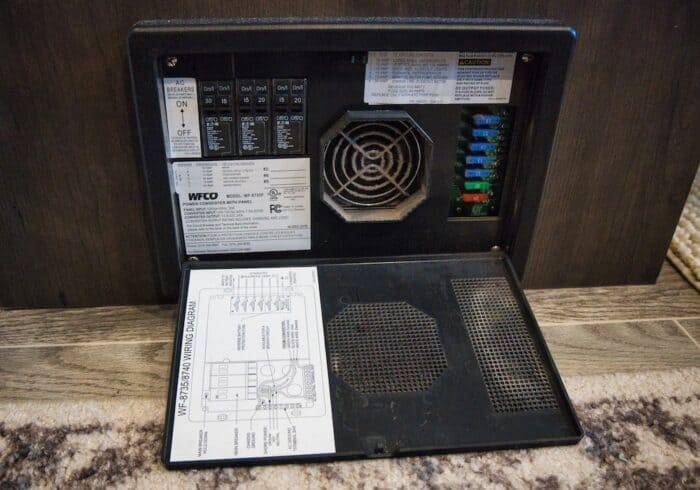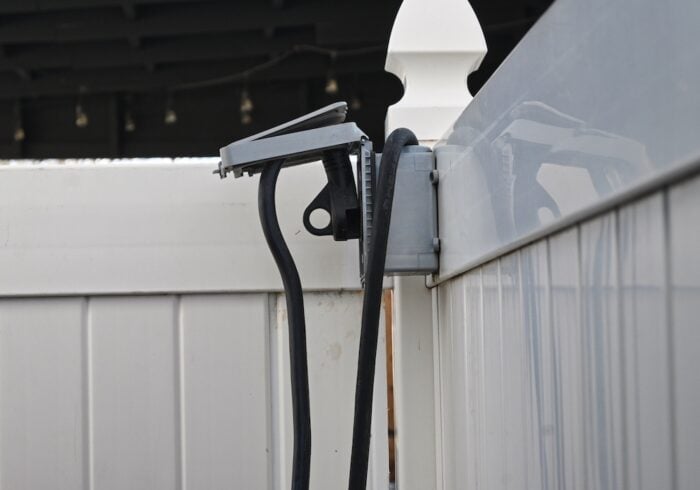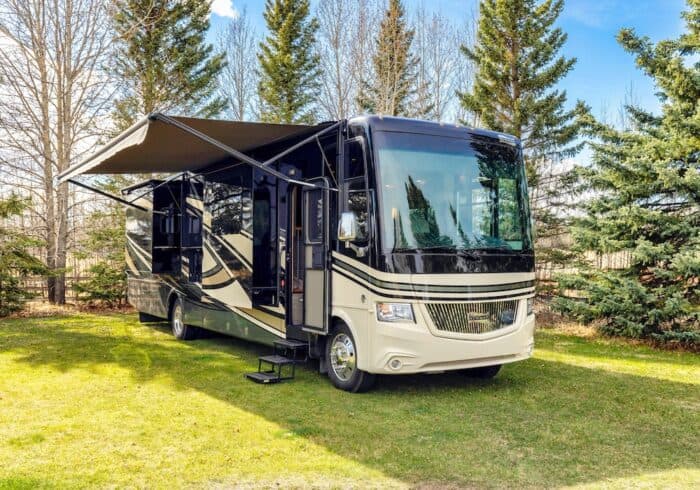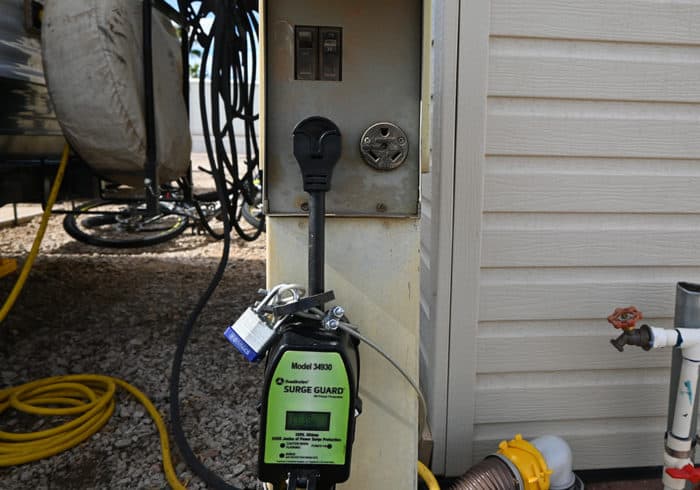30 Amp RVs vs 50 Amp RVs
RV electrical systems can be difficult to understand at first, but it’s important to know what you’ll get when deciding between a 50 amp RV or a 30 amp RV.
Related Product: See how level your RV is using an App on your phone with the LevelMatePro Wireless RV Leveling System (click to view on Amazon)
In this article, I’ll outline some of the key differences to help you get a better understanding of the two.
I’ll talk about what it would take to convert a 30 amp RV to a 50 amp.
Also, why you may hear 50 amp hookups referred to as 100 amp at some RV parks and campgrounds
See Also: What Do I Need To Use Hookups At An RV Park Or Campground?
RV 30 Amp vs 50 Amp Surprising Facts
A 50 Amp RV Get 3x More Power Than A 30 Amp RV
The first and most surprising thing about 50 amp vs 30 amp is that 50 amp RVs get over 3 times as much power as 30 amp RVs.
I know 50 isn’t a number that’s 3 times larger than 30, but the difference is huge.
If you look at it in terms of watts, 30 amp RVs receive 3,600 watts and 50 amp RVs get 12,000 watts.
That’s more than 3x as much power.
The reason for this is the power delivery system.
A 50 amp plug has 4 prongs and 2 of them give 50 amps of power each. A 30 amp only has one prong for power.
I’ll go more into detail about that further on in this article.
See Also: The Best Camping Gas Generators That Will Run Your RV AC
50 Amp RVs Can Run Way More Appliances At The Same Time
Another major difference is the number of appliances that can be run at the same time.
A 30 amp RV will barely be able to run one air conditioner and the microwave at the same time.
A 50 amp RV can run 2 air conditioners, the microwave, a washer or dryer, and a TV with no risk for tripping the breaker.

Different Power Centers
A 50 amp RV has two 50 amp circuit breakers (4 wire systems) because two of the wires supply 50 amps of power.
That’s why you can run so many appliances at the same time.
For instance, if you have two AC units, they may be run off of their own circuit and breaker.
That way, they don’t interrupt the use of a microwave and a washing machine, which will be run by a separate circuit and breaker.
See Also: How To Connect/Plug RV Camper Into Generator (15/30/50 Amp)
A 30 amp RV only has one 30 amp circuit breaker and everything runs off of it.
For instance, a small 13,500 RV AC commonly found in 30 amp trailers will use around 1,600 watts when running and even more when starting up.
A microwave will use around 1000 watts when running. That’s 2,600 watts being used just by two appliances.
If you have your water heater on electric as well, it will use around 1000 watts.
At this point, you will have gone over the capacity of your 30 amp power center and flipped the breaker.
Outlets
The wiring of the outlets is also very different.
A 30 amp trailer will have fewer outlets than a 50 amp one.
Even if you were to upgrade your 30 amp trailer to 50 amps, the amount of electricity that can be drawn from the outlets is still limited.
The way to get around this would be to add more outlets that are on their own circuit.
See Also: RV Life Hack: 6 Things You Can Do To Fix A Broken RV Outlet

The Plugs
This may seem like an obvious one, but I wanted to elaborate on the different plugs.
The plug to a 50 amp RV has 4 prongs because they use a 4 wire system.
There are two prongs that run 50 amps of power each into your RV, which increases the maximum watts that can be used at a time in your RV.
A 30 amp plug has only 3 prongs to run the 3 wire system into one 30 amp breaker.
You can use an adapter to plug a 30 amp RV into a 50 amp outlet because the 30 amp power cord can draw 30 amps of power from the outlet.
Everything in your 30 amp RV will run as if you were plugged into a 30 amp outlet.
All you need is a good 30 to 50 amp RV adapter (click to view on Amazon).
See Also: Best Portable Quiet Inverter Generators For RV Camping
You can plug a 50 amp trailer into a 30 amp outlet using an adapter, but things will run much differently in your RV.
It will be as if you suddenly have a 30 amp trailer. You won’t be able to use as many appliances at the same time as you normally would.
Even though it’s not optimal, 50 amp RV owners still might need to plug into 3o amp outlets every now and again.
Especially at older RV parks or small private ones.
I recommend always traveling with a 50 to 30 amp RV adapter (click to view on Amazon) just in case.

Can I Turn My 30A RV Into A 50A RV?
There are many benefits to having more power in your RV, travel trailer, or 5th-wheel, especially if you are an RV park full-timer who travels or lives in places with full hookups.
If you are a boondocker or dry camper, you won’t need or use the 50 amp capabilities as much because electricity will be limited to battery and solar capacity.
See Also: How To Wire Multiple 12V Or 6V Batteries To An RV
If you currently have a 30A RV and are finding yourself wanting more power, it’s possible to convert to a 50A system or do other things to get more power.
But converting a 30A RV to a 50A RV isn’t as easy as changing the size of the power cord or swapping out the breaker.
People who do this conversion often find that individual circuit breakers flip because the outlet system was only designed to handle 30 amps.
If you upgrade your RV to 50 amps, more outlets that are on their own circuit will need to be added.
See Also: Best Portable Power Station/Solar Generator For Camping
Compared to changing over to a 50 amp power center, a simpler way to get more power is to add another 30 amp panel and change the main power cord to a 50 amp one.
You can then add more outlets and connect appliances to the second 30 amp system.
This can be a more affordable way to make your RV capable of running more appliances at the same time.
The electrical systems in RVs are very important to get right.
Unless you are extremely knowledgeable in that area, you shouldn’t try this kind of endeavor without professional help.
Hiring a licensed electrician to do the swap or give advice on how many outlets you should add and how you should transfer the power will be the safest way to turn a 30 amp RV into a 50 amp RV.
What Does 100 Amp Service Mean At An RV Park?
Some RV parks and campgrounds offer what’s called “100 amp service.”
Before I started full time RVing, I used to wonder what kind of RVs use 100 amp service.
After these years, it has now been pointed out to me that 100 amp service means the power pedestal has 50 amp, 30 amp, and 20 amp outlets.
That’s 100 amps if you add them together.
See Also: Will A 50A RV Surge Protector Work In A 30A Outlet?

Surge Protectors
A good quality RV surge protector will stop most kinds of power surges from frying your RV electrical system and appliances.
Every RV owner should have one no matter how many amps their RV is.
For more information on surge protectors like how they work and what outlets you can use them on, plus some of the best options on the market today, check out this article here.
Have questions about 50 amp RVs vs 30 amp RVs? Leave a comment below.


I would like to recommend to edits to this post. I am an electrician and some of the information is incorrect in the post.
The wattage for the 30amp plug is correct. As well as the wattage for the 50mp.
The 50amp plug is a 4-wire 240v plug. Which uses a 2 pole 50amp breaker not ‘100amps’. If you attempt to run ‘100’ amps over that wire and breaker it will tell the breaker. They don’t provide 50amps on each leg rather a combined total of 50amps.
They are called 100amp services because they have a 50amp RV plug, 30amp RV plug and a 20amp GFCI outlet. Total all those together and you get 100amps.
Also surge protectors will prevent surges from happening but can not guarantee it will stop every single surge.
***and it will trip the breaker.***
I took a look at the article and made the proper changes. Thanks so much for the input and the clarification, I really appreciate it.
Hate to break it to you but you do get 50 amps per leg on a RV. The RV splits the two legs so they are used independently…
The company AM Solar has designed and patented an ATS that delivers 50 Amps to both legs simultaneously. I think they call it the smartATS.
It’s two separate 120v systems if you hook it up to 220v you will fry the sysrem
I Agree with Jason and Kurt and Disagree with Andrew. You do get 100 amps from a campground pedestal with a single 50 amp RV plug. The campground system supplies 120 volts at different current phases (or circuit legs). The 50 amp RV plug delivers 50 amps on one phase and 50 amps on a different phase or leg. On most RVs roughly half of the RV connections are on one leg and roughly half on the other so each half has 50 amps available to it. While 240 volts can be available to the RVs circuitry, typically none of the RV circuits combine the two phases or legs to get 240 volts to any appliance or outlet.
Does this mean that the neutral wire in a 50 amp system could potentially carry 100 amps?
No , because the legs (phases) , are 120 electrical degrees apart , so too will be the peak voltages , which is the ability to deliver power . The total current on the neutral will be … I think , 0.707 times 100 , or 70.7 A . Due to the odds of 100% power usage being really low , they roll the dice and give just enough ampacity for most normal use. Think of your home panel . It has a 200 Amp main … But if you add up the total of the individual breakers its way more than the main breaker . That panel gets you 40 spots for loads , but never all at once . Hope this helps
I think you are thinking of a 3 phase system. On a single phase system they are 180 degrees apart. The neutral carries the unbalanced load, so if A phase was pulling 40A and B phase had 30A, the neutral would only be carrying the 10A difference. Worst case scenario on a single phase 3-wire 50A system would be one leg with 50A and the other with 0A, this would put 50A across the neutral. This is why the neutrals are sized the same or slightly smaller than the ungrounded phases.
No. It’s rated for a max of 50 amps.
Only if wired wrong such as two L1 legs (L1 & L1) instead of L1 & L2.
WOW
This artical and comments are very confusing. Made me more confused the I already was.